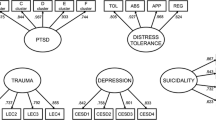Abstract
This study explored the impact of the 1995 Oklahoma City, Oklahoma, bombing on the spouses and significant others of a volunteer sample of Oklahoma City firefighters who participated in the bombing rescue effort. Twenty-seven partners of Oklahoma City firefighters participated in this study, conducted 42 to 44 months after the bombing. These partners were assessed using a structured diagnostic interview and a companion interview to examine exposure, rates of psychiatric disorders and symptoms, functioning, health, and relationships. Coping and perception of the firefighter partner's response were also examined. Some of the women were exposed directly; most knew someone who had been involved in the disaster, and all reported exposure through the media. The rate of psychiatric disorders in the women following the disaster was 22%, essentially unchanged from before the incident. One developed bomb-related posttraumatic stress disorder (PTSD). Most were satisfied with their work performance; 15% reported that their health had worsened since the bombing, and more than one third reported permanent changes in relationships as a result of the bombing. Most coped by turning to friends or relatives, with less than 10% seeking professional help. Many described symptoms in their firefighter mate; all reported that their mate had been affected by the experience, and one half said their mate had fully recovered. The mates of these firefighters fared relatively well in terms of psychiatric disorders, symptoms, and ability to function. The prevalence of bomb-related post-traumatic stress disorder was considerably lower in this sample than in samples of individuals more directly exposed to the bombing, although some reported changes in relationships and health. The results suggest the need for further study of the impact of interpersonal exposure in those who provide support for rescue-and-recovery workers in major terrorist incidents.
Similar content being viewed by others
References
Ersland S, Weisaeth L, Sund A. The stress upon rescuers involved in an oil rig disaster. Alexander L. Kielland 1980. Acta Psychiatr Scand Suppl. 1989;355(80):38–49.
Jones DR. Secondary disaster victims: the emotional effects of recovering and identifying human remains. Am J Psychiatry 1985;142:303–307.
Marmar CR, Weiss DS, Metzler TJ, et al. Stress responses of emergency services personnel to the Loma Prieta earthquake Interstate 880 freeway collapse and control traumatic incidents. J Trauma Stress. 1996;9:63–85.
Marmar CR, Weiss DS, Metzler TJ, et al. Longitudinal course and predictors of continuing distress following critical incident exposure in emergency services personnel. J Nerv Ment Dis. 1999;187:15–22.
McCammon S, Durham TW, Allison EJ Jr, et al. Emergency workers' cognitive appraisal and coping with traumatic events. J Trauma Stress 1988;1:353–372.
McFarlane AC. Avoidance and intrusion in posttraumatic stress disorder. J Nerv Ment Dis. 1992;180:439–445.
McFarlane AC, Papay P. Multiple diagnoses in posttraumatic stress disorder in the victims of a natural disaster. J Nerv Ment Dis. 1992;180:498–504.
McFarlane AC. The aetiology of post-traumatic stress disorders following a natural disaster. Br J Psychiatry. 1988;152:116–121.
Nixon SJ, Schorr J, Boudreaux A, et al. Perceived effects and recovery in Oklahoma City firefighters. J Okla State Med Assoc. 1999;92:172–177.
North CS, Tivis L, McMillen JC, et al. Coping, functioning, and adjustment of rescue workers after the Oklahoma City bombing. J. Trauma Stress. 2002;15:171–175.
North CS, Tivis L, McMillen JC, et al. Psychiatric disorders in rescue workers of the Oklahoma City bombing. Am J Psychiatry. 2002;159:857–859.
Wagner D, Heinrichs M, Ehlert U. Prevalence of symptoms of posttraumatic stress disorder in German professional firefighters. Am J Psychiatry. 1988;155:1727–1732.
Weiss DS, Marmar CR, Metzler TJ, Ronfeldt HM. Predicting symptomatic distress in emergency services personnel. J Consult Clinical Psychol. 1995;63:361–368.
Mitchell JT, Dyregrov A. Traumatic stress in disaster workers and emergency personnel: prevention and intervention. In: Wilson JP, Raphael B, eds. International Handbook of Traumatic Stress Syndromes. New York: Plenum Press; 1993:905–914.
Robins LN, Helzer JE, Cottler L, et al. NIMH Diagnostic Interview Schedule, Version 3—Revised. St. Louis, MO: Washington University; 1989.
American Psychiatric Association. Diagnostic and Statistical Manual of Mental Disorders, 3rd ed., revised. Washington, DC: APA; 1987.
Robins LN, Smith EM. The Diagnostic Interview Schedule/Disaster Supplement. St. Louis, MO: Washington University; 1983.
Smith DW, Christiansen EH, Vincent R, et al. Population effects of the bombing of Oklahoma City. J Okla State Med Assoc. 1999;92:193–198.
North CS, Nixon SJ, Shariat S, et al. Psychiatric disorders among survivors of the Oklahoma City bombing. JAMA. 1999;282:755–762.
Call JA, Pfefferbaum B. Lessons from the first two years of Project Heartland, Oklahoma's mental health response to the 1995 bombing. Psychiatr Serv. 1999;50:953–955.
Author information
Authors and Affiliations
Rights and permissions
About this article
Cite this article
Pfefferbaum, B., North, C.S., Bunch, K. et al. The impact of the 1995 Oklahoma City bombing on the partners of firefighters. J Urban Health 79, 364–372 (2002). https://doi.org/10.1093/jurban/79.3.364
Issue Date:
DOI: https://doi.org/10.1093/jurban/79.3.364



